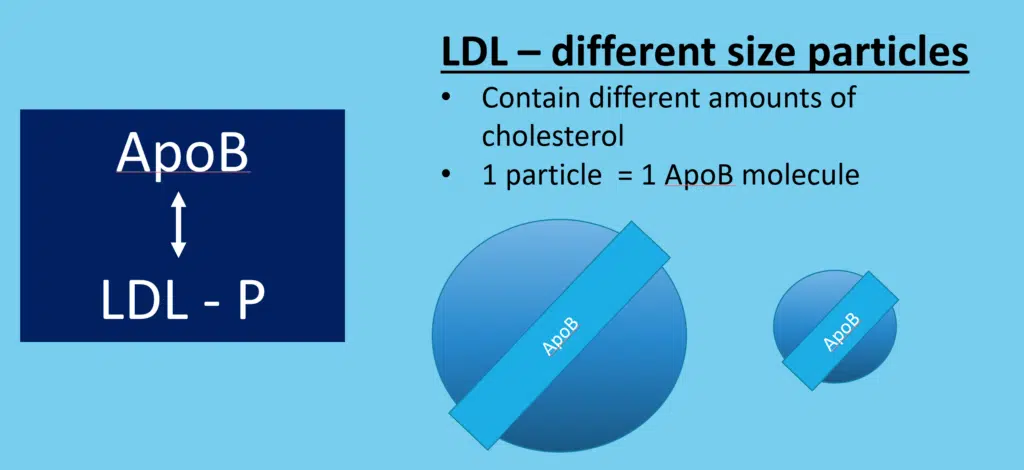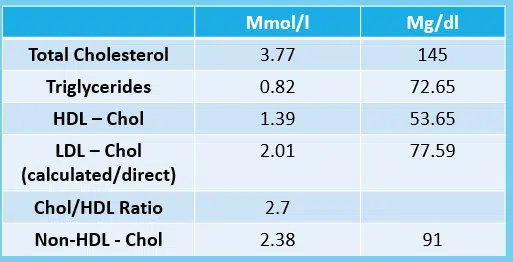Contents
Table of Contents
The standard lipid/cholesterol panel can be really confusing to understand! In this article I am going to talk about the different components of cholesterol blood work, and what they mean.
The Standard Panel
The table above shows the standard cholesterol panel. On the left-hand side, you’ve got the names of the standard components. In the two other columns, you’ve got the units and these vary
depending on where you are in the world. In broad terms –
Europe – millimoles per liter (mmol/l)
USA / Asia- milligrams per deciliter (mg/dl).
These units tell you the total amount of cholesterol in the particles in the blood sample, normalized to the patient’s blood volume.
For example: LDL – 200 mg/dl means there are 200 milligrams of cholesterol held in the LDL particles per decilitre of blood.
Total Cholesterol
Total cholesterol was the first measurement of cholesterol ever used. We don’t tend to use it now to guide treatment. We are more interested in things like Apolipoprotein B, LDL particle count, and LDL cholesterol when it comes to looking at the risk of heart disease. However, total cholesterol is still presented in the panel. It basically means the total amount of cholesterol held in all your lipoprotein particles added up.
Triglycerides
Triglycerides are a type of fat carried in your blood largely to be used for fuel. They are not lipoprotein particles like LDL or HDL. They are fats carried in two main particles. When you are fasting, the triglycerides are mainly carried in the blood by Very Low Density Lipoprotiens (VLDL) particles.
If you have just had a meal then triglycerides in your blood will be in your VLDL particles and in your Chylomicrons.
Chylomicrons are large particles that carry fats that are picked up in the intestines after eating. They transport them around the body for use or storage. They are not present when you are fasting for 8 hours.
The triglyceride level is the total amount of triglyceride found in your blood sample normalized by volume. If you are interested in your real triglyceride level in your VLDL particles then this sample must be done after fasting for 8 hours.
High Density Lipoprotein – Cholesterol (HDL-C)
The HDL particle is involved in cholesterol transport, inflammation and the immune system. The HDL-C number you see in the panel is the total amount of cholesterol found within all the HDL particles. It gives you an approximation for the number of your HDL particles, however, this number really tells you nothing about how these particles function. We now know that HDL particles are more complex than we initially thought.
Low Density lipoprotein cholesterol (LDL-C)
The LDL particle carries all the excess cholesterol made by the peripheral tissues to the liver. LDL-C cholesterol is the total amount of cholesterol found within all the LDL cholesterol particles in the sample.
Unlike the other particle numbers in the panel you will often see another word next to this – calculated or measured. Interestingly, of all the components, the LDL one is often just back-calculated and not actually directly measured.
There is an equation called the Friedwald equation, which calculates LDL based on the HDL and total cholesterol and triglyceride levels.
The problem with a calculated LDL is that it is often incorrect particularly if you have high triglycerides. You should always push your doctor to do a direct/measured LDL measurement. That means that the cholesterol has been directly measured within the LDL cholesterol particles, and not just calculated.
Cholesterol to HDL ratio
You’re often presented with a ratio of total cholesterol to HDL. The lower it is, the lower your risk of heart disease, however, we don’t really use that ratio anymore, and I would suggest you don’t bother with it either. ApoB, non-HDL cholesterol and LDL-P are more accurate for risk prediction.
Non-HDL cholesterol
Non -HDL cholesterol is the total amount of cholesterol in all the particles that are not high-density lipoproteins. It is actually a reasonably good measure of risk and often correlates with the Apolipoprotein B measurement.
More advanced lipid metrics

LDL particle size varies
In more advanced panels, you might see Apolipoprotein B or an LDL-P.
LDL particles and ApoB LDL particle size varies
LDL-P
LDL-P is the LDL particle number, it is the actual count of the number of LDL-particles in the sample and has nothing to do with their cholesterol content.
It is measured using nuclear magnetic resonance (NMR) and examines the total number of particles plus the size of those particles.
In fact, the reason why LDL-C is related to risk is that LDL-C is a surrogate measurement for the particle count. It is actually the number of particles and the size of those particles that is related to your risk of heart disease.
The more LDL particles you have and the smaller your particles the more likely they are to end up in the wall of your arteries, get oxidized and lead to atherosclerosis.
LDL-P is not often measured because the NMR test is more expensive and not so commonly done.
Apoliprotein B (ApoB)
ApoB is the single most important blood test to assess your risk of heart disease. It has consistently been shown to be the most accurate risk predictor, above LDL-C, Non-HDL cholesterol, and the ratio.
It is an excellent surrogate for particle number. The reason being is that on every single LDL particle, you have a single Apo B molecule.
The ApoB number you get directly correlates with the number of LDL particles. if you have a very high ApoB it tells us you’ve got a very high particle count, and that puts your risk of cardiovascular disease much higher. You can see how your ApoB compares to others with my calculator here.
Conclusion
The numbers in the standard lipid panel tell you the total amount of cholesterol in the corresponding type of lipid particle. These are actually a surrogate for particle number.
It is the particle number and size that mainly determines heart disease and stroke risk. ApoB is the most powerful and cheap test for assessing your risk, above all other measurements.





